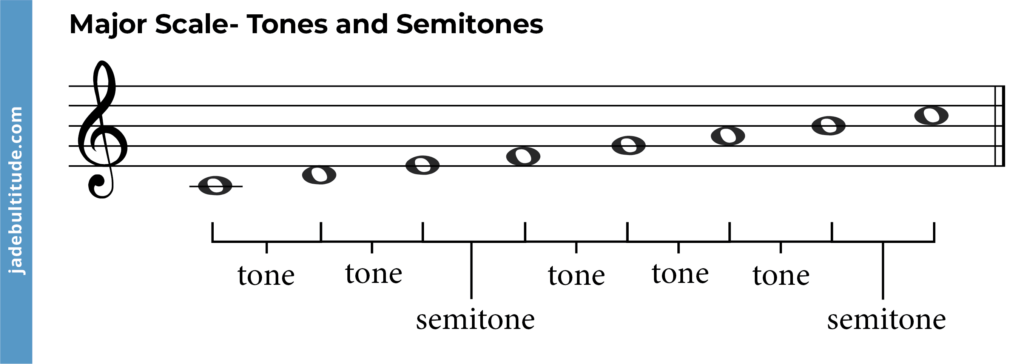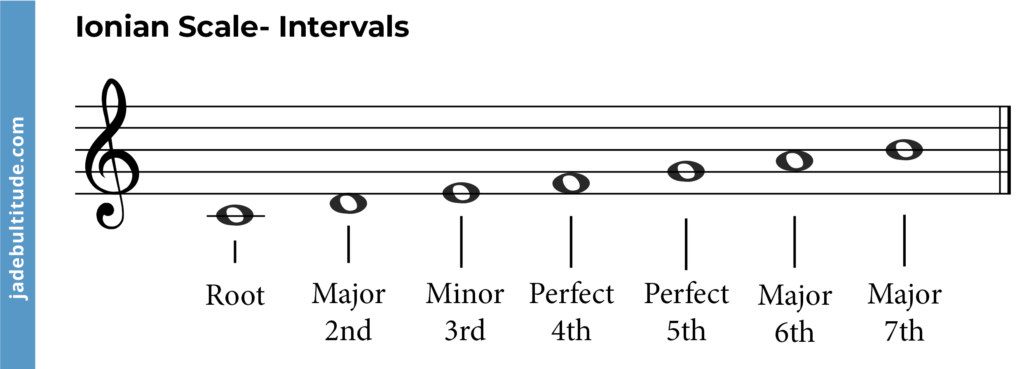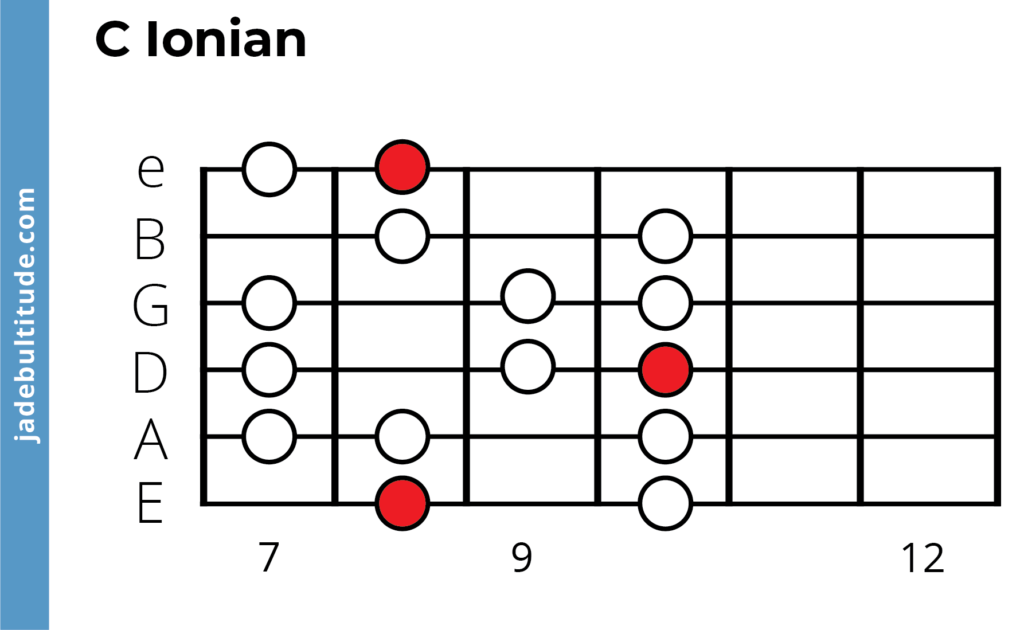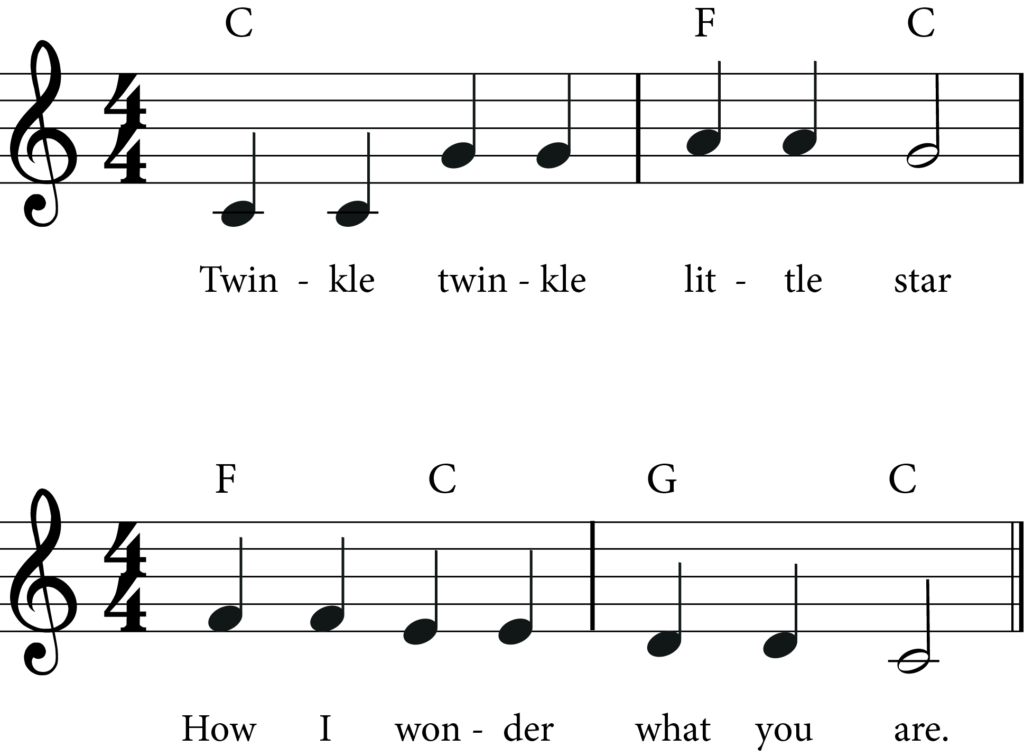There are many different scales in music theory and some are more common than others. You will have heard of major scales and the minor scales but the diatonic modes are something totally different.
What are musical modes: A Summary
The musical modes are a series of seven diatonic scales based on the major scale. The modes are sometimes referred to as Greek Modes or modal scales.
In any given major key you can play all seven modes. Each of these modes will start on a different scale degree. As you can see all the different modes are very closely related.
If we look at the note sequence of the seven modes in the C major scale they will be as follows:
C D E F G A B C – C Ionian Mode
D E F G A B C D – D Dorian Mode
E F G A B C D E – E Phrygian mode
F G A B C D E F – F lydian mode
G A B C D E F G – G Mixolydian mode
A B C D E F G A – A Aeolian Mode
B C D E F G A B – B Locrian Mode
All the notes above use the notes from the C major scale.
What is the Ionian Mode?
The ionian mode is the first mode. It is a mode that starts on the first scale degree of a major scale. As we saw above, if you are in C major, the ionian scale will begin on C. C is the first degree of C major, making the C ionian has the same notes as our modern day major scale.
If you are in the F major scale, the ionian mode will begin on F. F is the first degree of F major. The mode you create will then be the F Ionian scale which has the same notes as the F major scale.

If you are in the G major scale, the ionian mode will be begin on G. G is the first degree of G major. The mode you create will then be the G Ionian mode which has the same notes as the G major scale.

If you are in the Bb major scale, the ionian mode will begin on Bb. Bb is the first scale degree of Bb major. The mode you create will then be the Bb ionian mode which has the same notes as the Bb major scale.

Ionian Mode vs Major Scale
As we have seen, the ionian mode can be created from the first degree of a major scale. Remember scale degrees just refer to the number note of the scale.
The pattern of whole step and half steps (semitones and Tones) in the major scale is as follows:
Tone Tone Semitone Tone Tone Tone Semitone
Whole step, Whole step, Half step, Whole step, Whole step, Whole step, Half step

As the ionian mode has the same notes as the major scale, this pattern will simply stay the same.
Degrees of the ionian scale
The ionian mode is a major mode, in fact the ionian mode has exactly the same scale degrees as the major scale!
The degrees in a ionian mode will be as follows:
Root
Major second
Major third
Perfect fourth
Perfect fifth
Major sixth
Major seventh

How to play the Ionian Mode
You can play the ionian scale on any instrument. Whether you play the piano, guitar or flute all the modes will contain all the same notes on each instrument. All you must do is learn the notes (ionian mode formula) of that particular mode. Once you are comfortable playing scales you can then begin to play all the modes!
For example, the c ionian mode consists of all natural notes.
C D E F G A B C
This is the same as the c major scale, a diatonic scale from western music theory.
Learn these notes and you can play it on any instrument. Below you can see the notes on the piano, notice how the c Ionian scale uses only the white keys.


Music Written in the Ionian Mode
The ionian scale is classified as a major mode as it has the same scale degrees as the western music major scale. We can see the ionian scale used in many pieces as due to its unaltered scale degrees from the major scale. The ionian scale is seen in many different genres of music, pop, rock, jazz etc.
There are seven notes in a mode and it is possible to create a chord on each of these seven notes. The chords within the c ionian mode are as follows:

The tonic triad of the ionian scale is a major chord (c major chord) and this is what makes this a major mode. A major chord consists of a major third above the root and a perfect fifth above the root. The Ionian scale, much like the major scale, can have a fully functioning chord progression simply using the chords I (tonic), IV (subdominant) and V (dominant).
This very functional harmony is very often seen in traditional songs and in much popular music. A great example would be Twinkle Twinkle Little Star. This piece is written in the C Ionian mode or C major scale. It begins on the note C and simply uses the chords I, IV and V within the c major/c Ionian scale.

You will also see the Ionian mode in many popular songs as well. A great example is Tom Petty’s Free Fallin. This piece is written in F Ionian scale (The major scale starting on F). It uses the same chords as earlier, I, IV and V.
Another example would be the Ramones, ‘I wanna be sedated’. This is a great example from punk rock music! The piece is written in E Ionian scale (The major scale starting on E) and again uses the major chords I, IV and V.
List of Ionian Scales
The ionian scale is one of the easiest modes to create from the seven modes as it is the same as the major scale. As long as you keep the same interval pattern you can create the ionian mode on any note. Each of the modes below have been created using the whole step and half steps pattern we saw earlier.
C ionian mode – C D E F G A B C
C# ionian mode – C# D# E# F# G# A# B# C#
Db ionian mode – Db Eb F G Ab Bb C Db
D ionian mode – D E F# G A B C# D
Eb ionian mode – Eb F G Ab Bb C D Eb
F ionian mode – F G A Bb C D E F
F# ionian mode – F# G# A# B C# D# E# F#
Gb ionian mode – Gb Ab Bb C Db Eb F Gb
G ionian mode – G A B C D E F# G
Ab ionian mode – Ab Bb C Db Eb F G Ab
A ionian mode – A B C# D E F# G# A
Bb ionian mode – Bb C D Eb F G A Bb
B ionian mode – B C# D# E F# G# A# B
Which chord progressions can you use the Ionian scale with?
Ionian scale chord progressions are a series of chords derived from the Ionian scale. To build a chord progression in the Ionian scale you must first simply choose chords that can be created with these notes. The first place to start is to create a chord (triad) on every note of the chosen ionian mode. Below you can see a chord built on every note of the G Ionian scale, notice that this scale has an F#. If we follow the interval formula we saw earlier, with the starting note as a G, we end up with three chords that’s include an F#.

Each of these chords can then be labelled so you know what each chord is. If you need to learn more about these labels then make sure to check out our complete guide to chords.
Chord I in the G Ionian scale is a major chord as the interval between G and B is a major third. We will then label this chord with an upper case I to indicate that it is a major chord built on the root note of the scale. Each chord can then be labelled in this way and we will then know which chords have a minor quality and which ones have a major quality! If the chord has a major quality the third will be a major third and we will label this chord with capital Roman numerals, if the chord has a minor quality, the third will be a minor third and we will label this chord with a lower case roman numeral.

When writing a chord progression it is always advisable to use the root note chord first. This will establish the key you are in. The other chords that are important to keep when writing in ionian scales are the chords IV and V. This is important as these chords really help to establish the key of your music. Ionian scales are the same as major scales and so you can follow the same formula you use for writing in major scales when writing in an ionian mode!
Want to learn more?
To an overview of all the modes, check out our complete guide to musical modes. Or see our individual guides below:
- Dorian mode
- Phrygian mode
- lydian mode
- aeolian mode
- mixolydian mode
- locrian mode
